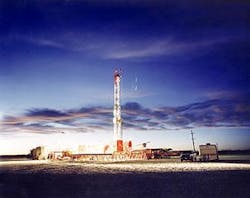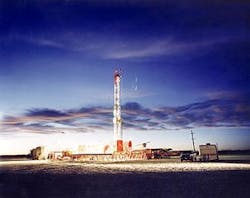Relays installed in Occidental Permian Ltd.'s operations in the Permian basin of West Texas and New Mexico have contributed to decreased power distribution and equipment failures caused by electrical storms, according to the relay manufacturer Schweitzer Engineering Laboratories, Pullman, Wash.
Schweitzer says "Anyone who works in the oil fields of the Permian basin understands the catastrophic damage that lightning can wreak on power systems. Frequent storms have plagued oil and gas producers in the Permian basin since they first began to drill there in the 1920s."
Oxy Permian is the largest oil producer in Texas because of its acquisition of Altura Energy Ltd. in April 2000. The acquisition included more than 6,400 producing wells in the greater Permian basin.
Initial relay installation
In an effort to improve production by avoiding downtime from electrical storms, Oxy Permian installed Schweitzer electrical relays for the purpose of learning more about the vulnerabilities of its power distribution system. According to Schweitzer, Oxy Permian began installing SEL-351R relays in 1998 to monitor, control, and protect its distribution systems.
Oxy Permian's power optimization resource team (PORT) collected data from the SEL-351R's events recorder function to determine what actually was happening with the power distribution system during and after electrical storms. The data, recorded in fractions of seconds, enable immediate corrective actions, according to Schweitzer.
Schweitzer says the results from the initial installation have prompted Oxy to conduct a system-wide optimization process that is now 60-70% complete.
New relays
More recently, Schweitzer indicates that Oxy Permian has begun to install SEL-701 motor protection relays on motors throughout the field for control and protection. It says Oxy Permian plans to standardize on the SEL-701 for motor protection, such as on electric submersible pumps (ESP).
Schweitzer explains that every ESP shutdown compromises the equipment and potentially leads to a reduced pumping life. Stopping a submersible motor causes backspin because fluid that is no longer under pressure falls by the pump vanes at the bottom of the well. The backspin can occur at intervals ranging from 20 min to 5 hr, and if not stopped completely before the motor restarts, the backspin can severely damage the pump shaft.
Not turning on the pump, on the other hand, in a timely manner will decease production from the well. The industry typically uses a timer to gauge backspin time, but any miscalculation can be expensive.
Schweitzer says Oxy Permian plans to use the SEL-701 to automate this function, and to date it has installed about 1,000 devices, with more being added all the time.
Oxy Permian's PORT team devised a strategy and design for a panel that prevents motors from dropping off during brownouts or bumps in the power system. Eventually the SEL-701 will tell the motor when to turn off, according to Schweitzer.
Ron Turner, Oxy Permian senior engineer and PORT team member says "If we put the SEL-701 in control of the situation, calculating for heat and other problems, we can have the motor to stay on to within milliseconds of when it should shutdown. We think that we can save a tremendous amount of money just by optimizing the controller through the SEL-701."
Oxy Permian also plans to install the SEL-701s on beam pumps. Schweitzer says this would eliminate the load cell that sits on the rod. Eliminating the load cell, according to Schweitzer, will eliminate the bulk of the failures because of the fact that load cells on the rod strings separating from the pump-off controller causes hundreds of controller and load cell failures each year.
Lightning
The SEL-351R relays throughout the Oxy Permian power distribution has substantially reduced debilitating electrical storm damage, according to Schweitzer. It says lightning was knocking out power distribution systems and damaging expensive equipment too frequently.
It adds that Oxy Permian was frustrated to see that residential power systems did not have the same vulnerability as the oil field systems. Residential appliances worked fine after residential power returned, but in the oil field storms in the same area resulted in complete failure of industrial-grade equipment that is supposed to last 20 years, according to Schweitzer.
The PORT team, using Schweitzer relays, learned that what caused the problems during electrical storms was not the lightning, but lightning amplified existing problems. Schweitzer says the source of the problems was the fact the 99% of the load was induction motor load that behaves differently from residential load during system upsets.
Once Oxy Permian understood that problem, it took the appropriate corrective action.
Schweitzer says currently, Oxy Permian has more than 100 such devices in the field and without them would have no effective way to maintain good power quality or a way to proactively look for improvements.
Power optimization
Schweitzer explains that its equipment also gave the PORT team a first look at what to look for when running computer models of Oxy Permian's power systems. The team now has field data that can be used with computer modeling to simulate system behavior to a greater degree of accuracy before capital is spent.
Computer models also can create topographical fault maps quickly to find faults in the system before Oxy Permian dispatches personnel to a location. This can significantly reduce downtime and use of resources.
Schweitzer says Oxy Permian has optimized about 60-70% of its distribution systems.
Oxy Permian also owns several substations where voltage is taken at transmission level and reduced to distribution level. Schweitzer says that in new stations as well as any improvements on older stations, Oxy Permian has installed SEL devices for the same reasons as in the oil field. It says, at the substation level, SEL devices improve the level of protection and reliability with much reduced requirements for maintenance.
Schweitzer estimates that use of SEL devices has reduced Oxy Permian power consumption by 1-3%.



